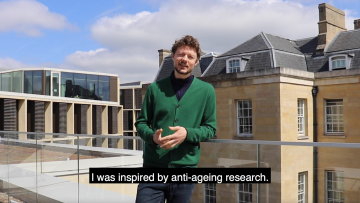A popular social media conjecture is that mathematics consists of a series of clever puzzles presented by a crew of witty magicians.
To test this, we spent the marvellous month of May travelling the Andrew Wiles Building, home to Oxford Mathematics, to find out what mathematicians actually do, and why.
In Episode 1 meet Jacobus, Maria and Sam.
Homological analysis of network dynamics
Abstract
Social, biological and physical systems are widely studied through the modeling of dynamical processes over networks, and one commonly investigates the interplay between structure and dynamics. I will discuss how cyclic patterns in networks can influence models for collective and diffusive processes, including generalized models in which dynamics are defined over simplicial complexes and multiplex networks. Our approach relies on homology theory, which is the subfield of mathematics that formally studies cycles (and more generally, k-dimensional holes). We will make use of techniques including persistent homology and Hodge theory to examine the role of cycles in helping organize dynamics onto low-dimensional manifolds. This pursuit represents an emerging interface between the fields of network-coupled dynamical systems and topological data analysis.
The ever-growing blob of fluid
Abstract
Consider the injection of a fluid onto an impermeable surface for an infinite length of time... Does the injected fluid reach a finite height, or does it keep on growing forever? The classical theory of gravity currents suggests that the height remains finite, causing the radius to grow outwards like the square root of time. When the fluid resides within a porous medium, the same is thought to be true. However, recently I used some small scale experiments and numerical simulations, spanning 12 orders of magnitude in dimensionless time, to demonstrate that the height actually grows very slowly, at a rate ~t^(1/7)*(log(t))^(1/2). This strange behaviour can be explained by analysing the flow in a narrow "inner region" close to the source, in which there are significant vertical velocities and non-hydrostatic pressures. Analytical scalings are derived which match closely with both numerics and experiments, suggesting that the blob of fluid is in fact ever-growing, and therefore becomes unbounded with time.
Written and recorded by Jamaican artist Junior Murvin in protest at police and gang violence in his home country, this song became a success in the US and UK and an anthem of the 1976 Notting Hill Carnival in London which broke out in to riots. The Clash also recorded a version as part of their fusion of reggae and punk.
Idealised and Real Contact Sets in Knots and other Tight Structures
Born in Scotland and a former member of the British Olympic sailing team, the mathematician obtained his doctorate in Oxford. After several years as professor of mathematics in Maryland, USA, he returned to Europe to the École Polytechnique Fédérale de Lausanne (EPFL), where he has worked for nearly 20 years.
John Maddocks is a prominent expert in the multiscale modeling of DNA, the nucleic acid-based biological molecule that carries genetic information. He is interested above all in the nanomechanical properties of DNA molecules. These properties determine how DNA is "packed" and stored in our cells.
Text adapted from TU Berlin
Abstract
It has been known for some time that the contact sets between
self-avoiding idealised tubes (i.e. with exactly circular, normal
cross-sections) in various highly compact, tight structures comprise
double lines of contact. I will re-visit those results for two canonical
examples, namely the orthogonal clasp and the ideal trefoil knot. I will
then show experimental and 3D FEM simulation data for deformable elastic
tubes (obtained within the group of Pedro Reis at the EPFL) which
reveals that the ideal contact set lines bound (in a non-rigorous sense)
the actual contact patches that arise in reality.
[1] The shapes of physical trefoil knots, P. Johanns, P. Grandgeorge, C.
Baek, T.G. Sano, J.H. Maddocks, P.M. Reis, Extreme Mechanics Letters 43
(2021), p. 101172, DOI:10.1016/j.eml.2021.101172
[2] Mechanics of two filaments in tight orthogonal contact, P.
Grandgeorge, C. Baek, H. Singh, P. Johanns, T.G. Sano, A. Flynn, J.H.
Maddocks, and P.M. Reis, Proceedings of the National Academy of Sciences
of the United States of America 118, no. 15 (2021), p. e2021684118
DOI:10.1073/pnas.2021684118



